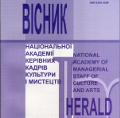Культурологічна методологія гендерного аналізу творів образотворчого мистецтва (на прикладі сюжету «Юдит і Олоферн» у Європейському живописі)
Cultural studies methodology of gender analysis of works of fine art (on the example of the story "Judith and Holofernes" in European painting)
Author(s): Olena Mykolayivna GoncharovaSubject(s): Gender Studies, Visual Arts, Social differentiation, Sociology of Culture, Sociology of the arts, business, education
Published by: Національна академія керівних кадрів культури і мистецтв
Keywords: cultural studies methodology of gender analysis; painting; European painting; "Judith and Holofernes"; Artemisia Gentileschi; Elisabetta Sirani; Fede Galizia; Virginia Vezzo;
Summary/Abstract: The purpose of the Article. Based on the generalized object of gender research as the interaction of men and women in society, to test the cultural studies methodology of gender analysis of works of fine art on the example of the story "Judith and Holofernes" in European painting. The methodology consists of a combination of a number of general theoretical: analysis and synthesis – and special methods of scientific research: chronological, problemchronological, historical-comparative, iconological, iconographic methods, method of formal-stylistic analysis, method of semantic analysis of visual series, and biographical and retrospective methods. The principle of psychoanalytic interpretation of art as a form of sublimation of the subconscious was taken into account. Scientific novelty. The study allows gaining new knowledge about the specifics of gender analysis in the field of art history and the application of its cultural studies methodology to the analysis of works of fine art. Conclusions. Applying the described methodology of analysis to the paintings on the gender-relevant plot "Judith and Holofernes", created by women artists and male artists, allowed us to conclude: 1) in quantitative terms, paintings by men are an order of magnitude higher than paintings by women artists; 2) with the exception of two paintings by Artemisia Gentileschi, whose composition is determined not only by an example of a similar painting by Caravaggio but also by dramatic events in the artist's life, the composition is based on the post-factum principle, 3) among the paintings by male artists stands out a quantitatively significant group of works in which, starting with "Judith" by Giorgione, there is an eroticization of the image of the protagonist, thus objectifying the erotic fantasies and desires of men; 4) in parallel with eroticism, thanatological objectification is formed: "eroticized death" (R. W. Whalen) and men's subconscious fear of "women's power".
Journal: Вісник Національної академії керівних кадрів культури і мистецтв
- Issue Year: 2021
- Issue No: 4
- Page Range: 9-19
- Page Count: 11
- Language: Ukrainian

